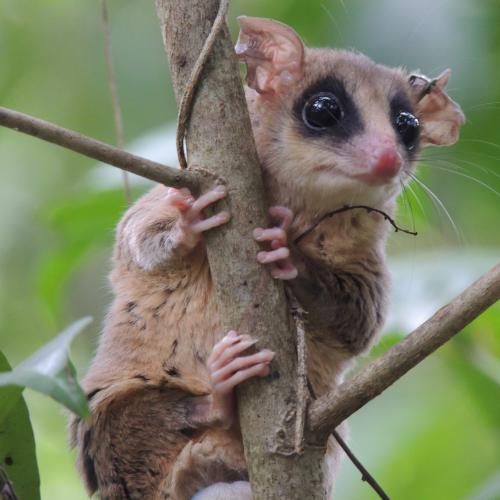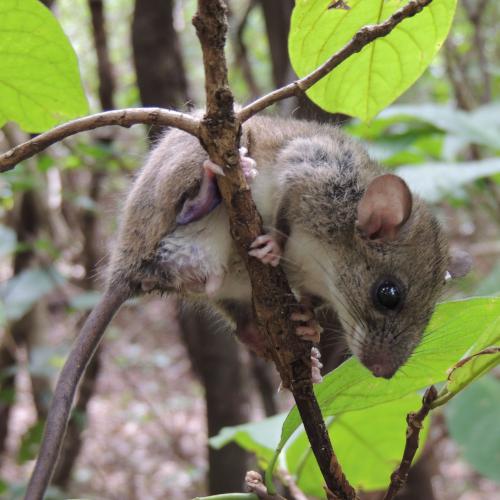Article featuring the project.
Ingrid de Mattos
This project aims to elucidate the responses of small mammal communities to habitat loss and fragmentation in a highly deforested Brazilian Cerrado region, from a taxonomic, functional, and trophic perspective. More specifically, this work aims to: 1) evaluate whether richness and taxonomic/functional diversity patterns are better predicted by landscape configuration (assessed as fragment size and isolation) and/or by habitat amount; 2) understand the role of fragment quality in maintaining small mammal abundance and diversity; 3) verify whether fragmentation acts like an abiotic filter to functional traits, as well as to phylogenetic groups; 4) elucidate how trophic relations in communities surviving in this changing environment are affected by fragmentation; 5) and finally, identify which species´ characteristics are associated with vulnerability/resilience to landscape fragmentation.

Marmosa murina (Didelphimorphia Didelphidae). It is an arboreal forest specialist marsupial species. It was a rare species in the study.
The Brazilian Cerrado is the largest and richest savanna of the world. Fragmentation and habitat loss are the main threats to its biodiversity. Yet, it is not clear how these habitat changes affect animals, how it impacts trophic relations, and which functional traits and phylogenetic lineages might be filtered out from these altered ecosystems or benefit from it. Thus, it is urgent to understand how key animal groups respond to fragmentation and habitat loss, elucidating the mechanisms associated with their ability to persist in these modified landscapes. Rodents and marsupials are abundant and diverse, respond to microhabitat characteristics and landscape changes, thus being potential indicators of environmental quality. As seed predators and dispersers, they influence plant community dynamics, and are important components of food webs as invertebrate consumers and prey to many predators. Understanding the relative effects of habitat loss and landscape configuration on biodiversity is essential to guide conservation programs and landscape restoration management policies.

Rhipidomys macrurus (Rodentia Cricetidae). A forest specialist, locally abundant arboreal and frugivore rodent species registered in the study.
The aim of this project is to elucidate the responses of small mammal communities to habitat loss and fragmentation in a highly deforested Brazilian Cerrado region, from a taxonomic, functional, and trophic perspective. The study will be conducted in semideciduous forest remnants located in private farms within three landscapes with different levels of habitat amount (10, 25 and 40%) in a highly deforested portion of Brazilian Cerrado in Goiás state, Brazil. Mark-recapture sampling will occur over one year in the rainy and dry seasons with sherman and tomahawk livetraps. Landscape structure will be evaluated as patch size, patch isolation and habitat amount in each landscape context. Patch descriptors of habitat quality will be assessed by measuring food availability, vegetation structure and by evaluating signs of human activity in nine quadrats along each trap line. Additionally, stable isotope values of carbon and nitrogen contents of consumers (using fur samples from captured small mammals) and food resources (fruits, invertebrates and pasture seeds) will be analyzed to examine changes in food-web structure and community-wide measures of trophic diversity driven by fragmentation and habitat loss.
Results from this work should lead to conservation action propositions for small mammals and ecologically similar organisms, also contributing to the scientific basis needed to improve landscape management. Moreover, it should also help strengthen scientific arguments against recent radical policy changes in the Brazilian legislation on the protection of native vegetation, which seek to benefit agribusiness sectors in spite of ecosystem conservation.